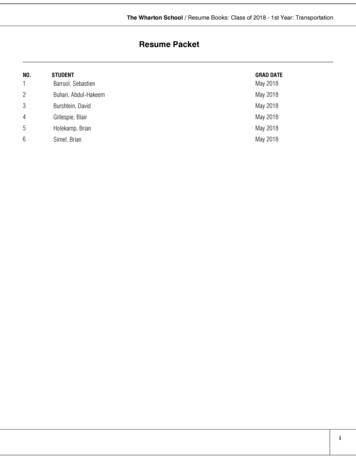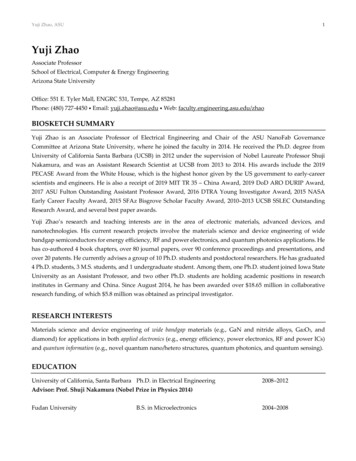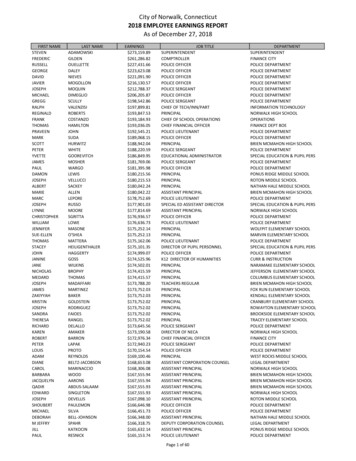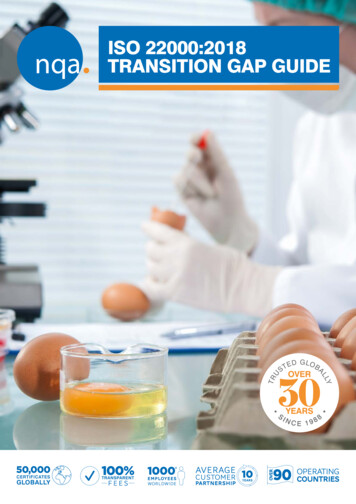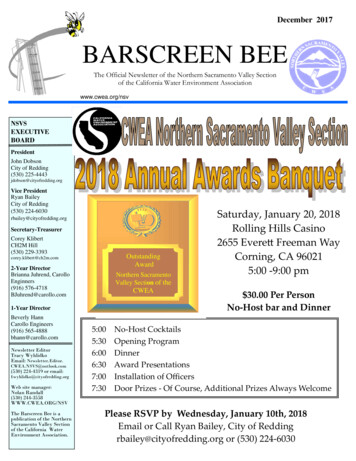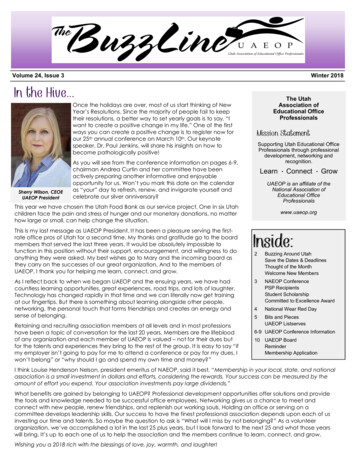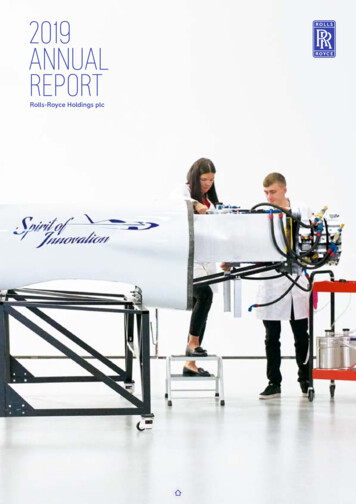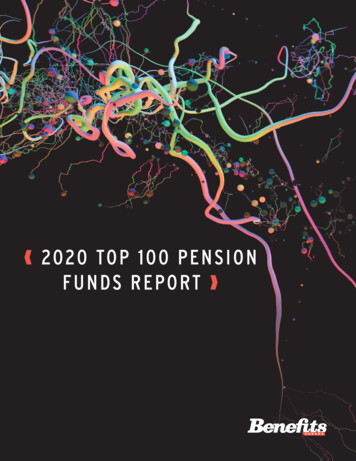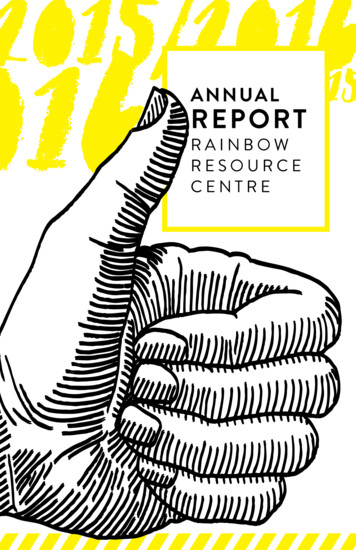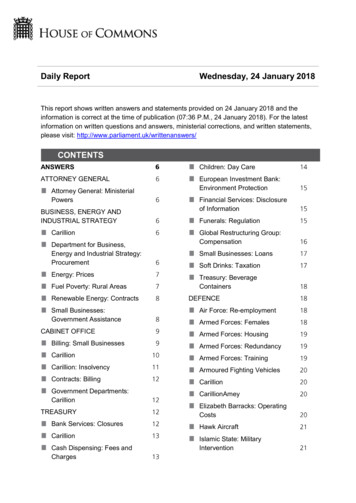
Transcription
FY 2018 Q3 REPORTAward # AID-514-T-16-00001April 1 2018 – June 30, 2018Cover photos: farmer field day with a FEDECACO extension agent
Contents1. EXECUTIVE SUMMARY . 1Cooperative Research . 1Agricultural Extension . 2Education . 3Technical Assistance. 32. PROGRAM OVERVIEW . 32.1PROGRAM DESCRIPTION . 32.2GEOGRAPHIC AREA TARGETED . 52.3Key Partners and Stakeholders . 62.4Deliverables Status. 83. PROGRAM FOCUS AREAS . 113.1. Cooperative Research . 113.2 Agricultural Extension . 133.3 Education . 153.4 Institutional Technical Assistance and other . 184. MONITORING AND EVALUATION . 195. ENVIRONMENTAL MONITORING . 226. AGREEMENTS WITH IMPLEMENTING PARTNERS . 22Annex 1 – USDA Cochran and Borlaug Fellowship Programs . 23
LIST OF APCVPNUDPSUSENASHRSSNPSOPSOWTSCBDUFLColombian Corporation for Agricultural Research (formerly Corpoica)American-Colombian Chamber of CommerceAgricultores de Productos Organicos del Municipio de DibullaUSDA Agricultural Research ServiceCadmiumCacao for Peace projectInternational Center for Tropical AgricultureColombian Corporation for Agricultural ResearchUSDA Foreign Agricultural ServiceColombian cacao producer associationColombian Agricultural Sector Financial FundGross Domestic ProductInstituto Colombiano AgropecuarioUSDA Land Grant UniversityColombian Ministry of Agriculture and Rural DevelopmentMinistry of Trade, Industry and –TourismMetric TonOffice of Capacity Building and DevelopmentColombian Tourism, Foreign Investment and Export PromotionPeace Corps VolunteerUnited Nations Development ProgramPennsylvania State UniversityColombian National Training Service (Servicio Nacional de Aprendizaje)Subtropical Horticultural Research StationSingle Nucleotide PolymorphismStandard Opperating ProcedureStatement of WorkUSDA/FAS Trade Scientific and Capacity Building DivisionUniversity of Florida
1. EXECUTIVE SUMMARYThe “Cacao for Peace” (CfP) initiative is a five year program that seeks to strengthen Colombia’spublic and private institutions in the cacao sector. The objectives are to increase cacao yields,increase cacao farmer incomes, and contribute to rural stability and peace in Colombia.Through CfP, USDA will build Colombia’s research and extension capability leading to theenhanced training of small cacao farmers. This is the program’s eleventh quarterly report, and itcaptures major accomplishments and activities. The period covered by this report is April 1st,2018 – June 30th, 2018. In FY 2018 Q3, CfP collaborated with partners to implement thefollowing activities and achieve the following results. Activities and results are grouped by CfPfocus areas, Cooperative Research, Agricultural Extension, Education and Technical Assistance:Cooperative ResearchUSDA-FAS is in the process of approving an award in the amount of USD 191,000 for aninstitution to use gene editing technologies for the reduction of cadmium absorption by cacaoplants. CfP will contribute USD 100,000 towards this initiative for a total of USD 291,000towards the project.Cadmium is a heavy metal in the soil that is absorbed by cacao in highly productive cacaoregions of Colombia. The EU will restrict chocolate and cocoa powder imports based oncadmium content beginning in 2019. In the U.S., California requires warning labels detailingcadmium content in chocolate products and other states may follow suit. In order to preventtrade disruptions, this quarter CfP endeavoured to obtain the USDA-FAS funding mentionedabove and in addition trained a Colombian researcher on how to detect cadmium in cacao inorder to understand and prevent its absorption by the plant.USDA’s Agricultural Research Service and USDA Land GrantUniversity, University of Florida, trained Agrosavia scientist onthe use of different methodologies for the determination oftotal and bioavailable cadmium, and other heavy metals insoils. In addition, they studied the use of acid digestions tomeasure total concentrations of metals in plant tissues andsoils.Agrosavia scientist conducting soilanalysis at the University of Florida.1
USAID/USDA Colombia Cacao for Peace FY2018 Q3 ReportIn order to effectively identify cacao genetic accessions that areproductive and disease resistant, it is important that Colombia’snational cacao germplasm bank be properly classified. USDA’s ARSconducted an analysis of Colombia’s cacao collection and found ahigh rate of classification duplicity and misclassification. Toaddress these issues, CfP financed Agrosavia scientists to collectcacao samples from Colombia’s germplasm bank for analysis andclassication by ARS. The scientists collected 2,800 plant tissuesamples representing Colombia’s entire germplasm bank. Thesamples will be shipped to ARS for analysis and proper classificationin the coming weeks.Plant tissue samples collected byAgrosavia for analysis by ARS.CfP executed agreements with CIAT, NRCS, and Penn State University for the development ofa Geographical Information System (GIS) to support increased cacao productivity in the SierraNevada de Santa Marta (SNSM) region. This CfP initiative will research and map regional soilcharacteristics, water supply and cacao genetics. Doing so will promote a deeper understandingof spatial variability of soil characteristics and cadmium, water supply for cacao cultivation, andassess the diversity of plants. This project seeks to define suitable areas for optimal andsustainable cacao production and to identify high-yielding and high quality cacao varieties. CIATwill lead in-country activities and collaborate with USDA Natural Resources ConservationService (NRCS) for soil and water analysis methodology, and Pennsylvania State University (PSU)for soil and genetic data analysis methodology.Agricultural Extension738/750 cacao plants were successfully grafted byCfP trained producers at 9 CfP farms. The highgrafting success rate (98.4%) will greatly assistproducers in their replacement of unproductivetrees.Cacao nurseries used to cultivate cacao plants forgrafting.Fedecacao extensionist provides training to cacaofarmers and PCVs at Cacao Boot Camp.22 cacao producers were trained on goodagricultural practices (Cacao Boot Camp) at theFedecacao training center in San Vicente deChucurí. In addition, 2 Peace Corps volunteers anda SENA trainer were trained. Producers and theSENA trainer committed to implementing thetraining on their farms as well as to replicate thetraining in 3 additional farms. CfP technicians willassist with these training to provide support andverify their implementation.2
USAID/USDA Colombia Cacao for Peace FY2018 Q3 ReportCfP Peace Corps volunteers provided assistance to cacao association members in the followingareas: establishment of new points of sale for association chocolate products, coordination offormal business administration training, refurbishment of a cacao collection center, andsupport for producer good practices trainings.EducationTwo CfP-Colfuturo scholarship recipients have arrived at Purdue University and began theirstudies towards obtaining PhDs. A third student will begin in Fall of 2018. One studentcompleted his first semester and is working with a professor in the Department of Agricultureand Biological Engineering on standardizing the quality of cocoa powder in Colombia.Two CfP Fulbright-Colombia scholarship recipients attending Penn State University conductedfield research in Colombia during this reporting period. One student conducted interviews insupport of her thesis which seeks to identify factors that influence the adoption of new cacaocultivation practices. The other student conducted interviews and gathered informationfocused on the effectiveness of cacao sector assistance programs.Purdue and CIAT completed the English version of the final cacao supply chain study.Technical AssistanceCfP is developing an interinstitutional pest management project (IR-4) to identify and testpesticides for controlling cacao diseases, define maximum residue levels to avoid cacao tradedisruptions, and train farmers on pesticide use good practices. This quarter USDA technicalexperts visited Colombia and found significant interest by Agrosavia and Fedecacao to commitresources to help MRL field trials be successful. Also, field site visits to San Vicente and SantaMarta delivered potential field sites for trials to be conducted.CfP partnered with the University of Florida to promote Colombian cacao as child labor free, inaddition to the research collaboration mentioned above. This quarter UFL isubmitted a revisedstatement of work based on feedback received from the Colombian Labor Attaché during a visitto Colombia in May. The project will shift from certifying associations as child labor free to childlabor prevention training for CfP cacao farmers. The trainings will focus on youthempowerment within the context of cocao farming and production in Colombia.2. PROGRAM OVERVIEW2.1 PROGRAM DESCRIPTIONThe United States confectionery industry, which relies on cacao imports, accounts for 35billion in annual retail sales, and directly employees 55,000 people in the United States. Inaddition, more than 400,000 jobs in agriculture, retail, transportation and other industries relyin part on the sale of confections. For every job that is created in confectionery, another sevenare supported in related industries. Annually the U.S. confectionery sector purchases more than 770 million in sugar, 450 million in U.S. dairy products, 190 million in peanuts (mostly fromU.S. farmers), and 150 million in California almonds and nuts. Annual exports of U.S. chocolateand cocoa products are approximately 1.7 billion (up 145% in the past 10 years).3
USAID/USDA Colombia Cacao for Peace FY2018 Q3 ReportCfP has three high level goals: 1) boost cacao output from Colombia to the U.S. to ensure theU.S. confectionery industry continues to have a reliable source of cacao, 2) develop the U.S. fineflavor chocolate market through increased access to fine flavor, fine aroma Colombian cacao,and 3) contribute to rural stability and peace in Colombia. In order to achieve these three goals,CfP will strengthen Colombia’s public and private institutions in the cacao sector by:1) strengthening local cacao research capacity for the development of new practicesand inputs;2) increasing in-country capacity for agricultural extension, and providing agriculturalextension assistance that increases productivity and cacao farmer incomes;3) providing educational opportunities for cacao researchers and stakeholders toobtain post-graduate degrees and training and4) providing technical assistance through a value chain analysis study and follow-upactivities; developing a cacao market information system; exploring the feasibility ofcertifying Colombian cacao child labor free; identifying pesticides to combat cacaodiseases; and establishing maximum residue levels for cacao disease pesticides toprevent trade disruptions.While cacao is native to the region, Latin America lags substantially behind West Africa in cacaoproduction. In 2014, Latin America produced approximately 16% of the total world productionof cacao. Within Latin America, Colombia is the fifth largest cacao producer, after Brazil,Ecuador, the Dominican Republic and Peru. In 2017, Colombia produced 60,535 metric tons(MT) of cacao. In 2016/2017, Cote d’Ivoire, the top global producer, is expected to produce1,900,000 MT of cacao.Colombian and regional Industry experts believe that cacao is an underdeveloped domesticindustry with great potential. These experts are confident that Colombia can become one of thelargest cacao producers in the world. Rural violence and lawlessness have negatively impactedagricultural investments and growth in rural Colombia.The potential growth of the cacao sector has substantial promise for being an engine for jobcreation and inclusive economic growth within Colombia. Foremost, cacao is produced bysmall-scale farmers with very low incomes. According to FEDECACAO, the Colombian cacaoproducers association, there are 38,000 cacao producers in Colombia. As cacao comprises acritical cornerstone within the rural economy of Colombia, increasing cacao yields and cacaofarmers’ incomes represents a strong potential opportunity for advancing USAID’sdevelopmental objectives in the country.4
USAID/USDA Colombia Cacao for Peace FY2018 Q3 Report2.2 GEOGRAPHIC AREA TARGETEDThe program selected the Sierra Nevada de Santa Marta region as a zone of focus for thefollowing reasons: Producers have successfully transitioned from coca to cacao as a means of alternativedevelopment It has access to three ports Unique fine flavored cacao genetic varieties are present Peace Corps, Fedecacao, and UNODC expressed interest in collaborating in the region USAID requested CfP work in the regionCfP is currently providing training and technical assistance to cacao producers from threeassociations: Guardabosques de la Sierra (San Rafael), APOMD (Dibulla), and Aso-Arhuaco(Perico Aguao). CfP is also working to strengthen the capacity of Fedecacao and Agrosavia . Inthe future, CfP plans on expanding to Aracataca – Fundación, Magdalena; San JuanNepomuceno, Bolivar; and Valencia and Tierralta, Cordoba. If security conditions allow,Caucasia will included in the expansion.Current Activities: Sierra Nevada de Santa Marta Regiono Dibulla, Perico Aguao, San Rafael Bogotá – Fedecacao capacity building Palmira – Agrosavia capacity buildingFuture Activities: Aracataca – Fundación, Magdalena San Juan Nepomuceno, Bolivar Valencia and Tierralta, CordobaMap of Colombia with work areas highlighted5
USAID/USDA Colombia Cacao for Peace FY2018 Q3 Report2.3 Key Partners and StakeholdersCfP has brought together key partners interested in strengthening the cacao-chocolate valuechain in Colombia through its activities and coordination efforts. CfP is working with thesepartners to conduct activities in the areas of 1) cooperative research, 2) agricultural extension,3) education and 4) institutional technical assistance. Activities in these areas will assistColombia increase cacao productivity and yields for the country to reach its productivepotential.Table 1 Key PartnersPartnerAgricultural Research Service (USDA)Agrosavia (formerly eace Corps – ColombiaPennsylvania State UniversityPurdue UniversityUNODCUniversity of FloridaCooperativeResearchFocus AreaAgricultural EducationExtension TechnicalAssistance In addition, CfP has involved the following key stakeholders as participants and/or collaboratorsin relevant activities: Agustin Codazzi Geographical Institute (IGAC, Spanish acronym) Casa Luker Colombian Ministry of Agriculture (MADR, Spanish acronym) FEDECAFE Finagro Alexander Von Humboldt Institute (Colombian biological resources research institute) Compañía Nacional de Chocolates PROCOLOMBIA Red Cacaotera Rural Agricultural Planning Unit (UPRA, Spanish acronym) of MADR Swisscontact Universidad de Caldas Universidad de Magdalena Universidad Nacional Insituto Colombiano Agropecuario (ICA) Private sector investors FINTRAC (USAID Producers to Market Alliance Program)6
USAID/USDA Colombia Cacao for Peace FY2018 Q3 ReportUSDA’s Foreign Agricultural Service has contributed a significant amount of financial resourcesto the project, and the CfP team has had great success mobilizing and leveraging funding frompartners.Table 2 USDA In-Kind Contributions, Mobilized and Leveraged FundsContributorExpenseUSDA In-KindFAS/BogotáTravel, Salary, and ServicesFAS/Washington D.C.Penn State Research SymposiumFAS/Washington D.C.Cochran Fellowship Program (5)FAS/Washington D.C.Borlaug and Scientific Exchanges (3)FAS/Washington D.C.Ecuador StudyMobilized and LeveragedColfuturoFEDECACAOScholarship (3)Training and Technical AssistanceFulbright-ColombiaScholarships (4)Pennsylvania State UniversityTuition Waivers for Fulbright ScholarsPurdue UniversityPartial Tuition WaiverUNODCTraining and Technical Assistance7
2.4 Deliverables StatusThe table below provides the status of project deliverables organized by focus area and partner(s).Focus AreaPartner(s)CooperativeResearchPenn StateUSDA/ARSDeliverableA technical document containing the organization and implementation of thecacao research meetingEstimatedCompletionCompleteTechnical document describing the cacao research agenda for the Caribbeannode including priority cacao research areas as identified and agreed upon bythe participants of the strategic planning session in during the researchmeeting in Barranquilla, May 2017Seed grant program. Seed grant will be used to fund cadmium reduction incacao through gene editing project.Proposal for implementation of a strategy for future funding of collaborativeresearch in Colombia. Proposal should analyze the current funding sourcesavailable in-country and internationally.Public CfP web‐based multi‐stakeholder knowledge platform for cacaoCompleteScientific publication in high impact journal2019Collaborative Research Agreement between ARS and CorpoicaCompleteIdentify new cacao collections of new genetics from ColombiaSeptember2019September2018September2019A rationalized cacao collection with minimum mislabeling and redundancyIdentified germplasm accessions, and alleles for key agronomic traits andquality attributesDevelop breeding activities that will generate new cacao varieties withimproved traits such as high productivity, disease resistance and newrootstocks that limit cadmium uptakeTest a set of superior cacao clones developed by ARS under high diseasepressureAssess the biodiversity collection of cacao disease causing organisms8End UsersCIAT, Corpoica,FEDECACAO, ColombianCacao Researchers, USbased cacao 019September2019September2019Corpoica and theColombian cacao researchcommunity, extensionists,cacao producers
USAID/USDA Colombia Cacao for Peace FY2018 Q3 ReportFocus EDECACAOFulbrightColombia,Penn ssistancePurdueCIATDeliverableResearch to improve the management and production and address priorityissues, such as cadmium and heavy metal toxicities.Demonstration farms ompleteActivities led by UNODC and FEDECACAO, supported by USDA-USAID leadingto its Capacity Building for Training and technical assistance for FEDECACAOIn Progress1/2021Four postgraduate degrees in agricultural fields from Penn State University forColombian cacao researchersMSc. research projects in support of CfP objectivesJune 2019Three Colombian post‐graduates trained to contribute to the Colombian cacaosectorThree graduate research theses and peer reviewed publications. Purdue willensure that theses and peer‐reviewed publications are aligned with the Cacaofor Peace objectives stated in the USAID/USDA Participating Agency ProgramAgreement.Research thesis concepts. Researchers will develop research proposalconcepts during the first few months at Purdue which will be presented to FASin a virtual workshop for comments.Trip reports for any trips taken by the CfP‐Colfuturo researchers.June 2020Organization and execution of workshop to present cacao value-chain studyand solicit feedbackFinal version of the supply chain and extension studies. Final products mustbe delivered in Spanish and English. Study will include analysis of Ecuadorvalue-chain to determine how the country has been able to grow into amajor international cacao exporter.Value-chain Study Booklet in English and Spanish.9Within 10days of tripCompleteAugust 2018EnglishCompleteCompleteEnd UsersCacao producers,FEDECACAO, CacaoExtensionistsColombian CacaoResearchers, Colombiancacao sectorUSAID, CfP, FEDECACAO,Red, Corpoica, U. Nacional,other key stakeholders
USAID/USDA Colombia Cacao for Peace FY2018 Q3 ReportFocus AreaDeliverablePartner(s)Penn StateUFL – ChildLaborUFL on and execution of workshop to present final Value-chain StudyCacao genetic diversity map for Sierra Nevada de Santa Marta region includinginformation on the genetic type, location, photographs and other notes ontrees growing on farms in our target communitiesDatabase including the information of the cacao genetic survey: sampled plantlocations, raw SNP data files for all genotypes, genetic ancestry analysisEstimatedCompletionCompleteFebruary2020End UsersCorpoica, CIAT, U.Nacional, Fedecacao,extensionists, CfP, andcacao producersSpecific recommendations for future improvement of genetic diversity and orpotential marketing strategies based on genetic varietiesScientific publication in high impact journalFebruary20202020Analytical report on why certification was selectedTraining Program for a Corpoica scientist actively involved in cacao researchSeptember2019CompleteFedecacao, extensionists,CfP, and cacao producersCorpoicaFinal ReportAugust 2018Corpoica and CfPFungicides registered for use and available to farmersJune 2019Residue data submitted to Codex to establish MRLsJune 2019Corpoica, CIAT, U.Nacional, Fedecacao,extensionists, CfP, cacaoproducersCacao exporters and ICA10
USAID/USDA Colombia Cacao for Peace FY2018 Q3 Report3. PROGRAM FOCUS AREASThe purpose of CfP is to strengthen Colombia’s key cacao agricultural institutions in the publicand private sectors with 1) cooperative research, 2) agricultural extension, 3) education, and 4)institutional technical assistance. CfP will expand longer-term opportunities in ways that spreadthe benefits of investments, economic growth and development to help Colombia’s cacaobecome more competitive and profitable. Using a whole of government approach, CfP willsupport Colombia’s peace process by establishing a road map for post-conflict agriculturaldevelopment, focusing on cacao and facilitating initiatives to improve economic opportunity,stability, and peace in targeted rural areas.3.1. Cooperative ResearchCfP is funding USDA’s Agricultural Research Service (ARS) and the Colombian Corporation forAgricultural Research (Agrosavia) to work collaboratively on the following activities:Activity 1: Assess genetic diversity of Agrosavia’s entire cacao collection. This will be doneusing single-nucleotide polymorphism (SNP) fingerprinting, identifying and eliminating offtype and duplicate entries, assessing diversity gaps in the collection, and surveying thegenetic diversity of on-farm and wild cacao populations.Activity 2: Develop breeding activities that will generate new cacao varieties with improvedtraits, such as high productivity, disease resistance, and limited cadmium uptake.Activity 3: Assess the common diseases of cacao, and determine the biodiversity of thesedisease-causing organisms to better understand their underlying biology and improvedisease control measures.Activity 4: Research and transfer best agronomic practices to improve the management andproduction of cacao, and address the priority issue of cadmium.11
USAID/USDA Colombia Cacao for Peace FY2018 Q3 ReportDuring this reporting period CfP conducted activities in collaboration with Agrosavia underactivities 1 and 4. With regards to activity 1, Cfp financed scientistand collegues to collect leaf samples from Agrosavia’s entiregermplasm bank. They travelled to Palmira from Bogota andspent 4 days collecting the samples. Five large boxes containing2800 leaf samples were transported to Bogota and then toTibaitata research center located in Mosquera. The samples werecollected conserved in paper bags and stored in bags with silicagel (provided by ARS) to avoid the DNA degradation. The samplesneed to be processed at Agrosavia. They will be cut into 5cm xCacao plant tissue sample5cm, packaged in Ziploc bags and sent to the USDA’s ARS for genetic analyses. This activity willallow Agrosavia to effectively identify cacao genetics accessions that are productive and diseaseresistant. In terms of activity 4, CfP executed an agreement with the University ofFlorida to trainCorpoica scientist on the identificationof cadmium in the soil and in plantmaterial. The training was carried outin the IRREC Soil and Water ScienceLaboratory of University of Florida,where she obtained specific knowledgeon the methodologies employed forinvestigatingsoilchemistryofcadmium, including the determinationof available cadmium (Cd) in soil andsoilCdfractionation(waterUFL Professor and Agrosavia researchersoluble/exchangeable, carbonate-bound,oxides-bound, organic matter-bound, and residual). For estimation of available Cd in soils,several methods of single extraction (0.01 M CaCl2, 0.1 N HCl, Mehlich 3 and 0.5 M NH4Ac) wereused and compared for their efficiency and applications. For the realization of theseexperiments, they worked together with a visiting scholar from China, a chemist and laboratorytechnician and UFL staff.Corpoica scientist learned to estimate total Cd in soil using USEPA 3050 method (USEnvironmental Protection Agency, 1995b), for which they received training from the LaboratoryTechnician II on the use of the digestion block for both plant tissue and soil samples. Finally,the Laboratory Technician II gave the training on the management of the ICP-OESequipment, by using this equipment all the samples obtained for soil and plant tissue wereanalyzed, the concentrations of cadmium were obtained of the acid digestions as well as thefractions obtained from single and sequential extractions.In addition, during the second week of the training, the visiting scientist gave an oralpresentation entitled "Pollution of heavy metals to the soil and effects on human health" at the12
USAID/USDA Colombia Cacao for Peace FY2018 Q3 Reportmonthly seminars of Soil and Water Science Lab that is programmed for students and visitingscholars.The objectives of the training program were achieved. Corpocia learned to use differentmethodologies for the determination of total and bioavailable cadmium (Cd), and other heavymetals in soils, in addition, they studied the use of acid digestions to measure totalconcentrations of metals in plant tissues and soils. Finally, they learned how to operateinductively coupled plasma optical emission spectroscopy (ICPOES) for analyzing elementalconcentrations of Cd and other heavy metals in soil extracts and plant/soil digesters; anddeveloped skills for future operation of ICP-OES in the Colombia based laboratory.In addition, under this focus area CfP expects to receive funds from USDA’s FAS in support of agene editing project for the reduction of cadmium absorption by cacao plants. The objective ofthis project is to develop, through genome edition technologies, cacao plant varieties producedin cultivation by selective breeding (cacao cultivars) that do not absorb the heavy metalcadmium (Cd). Beginning in January of 2019, cocoa powder and chocolate imported by theEuropean Union (EU) will be restricted based on Cd content. In California, a warning label isalready required on products that have more than 4.1 mg of Cd per daily serving of a singleproduct. Cacao produced in some Latin American countries, including Colombia, suffer from Cdcontamination. The development of these cacao cultivars would help to prevent the disruptionof cacao exports from Colombia and the corresponding loss of income for cacao smallholders.In Colombia (and in the region), cacao is considered a viable alternative to coca production. Inorder to successfully promote cacao as an alternative to coca, a viable long term solution to thecadmium content issue must be developed.Finally, under this focus area, in May 2018 CfP executed agreements with CIAT, USDA’s NRCS,and Penn State Univeristy for creation of an ArcGIS online map with multiple layers includingsuitability for cacao, cadmium content, water supply, and cacao genetic varieties andcharacteristics to support increased cacao productivity in three communities located in theSierra Nevada de Santa Marta region. The online map will bolster cacao
This is the program's eleventh quarterly report, and it captures major accomplishments and activities. The period covered by this report is April 1st, 2018 . Cadmium is a heavy metal in the soil that is absorbed by cacao in highly productive cacao regions of Colombia. .


